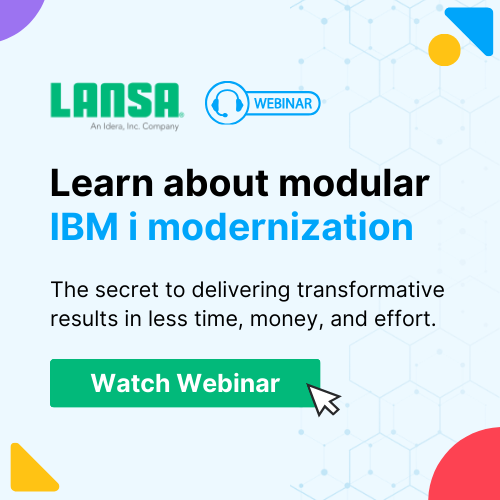For more than three decades now, thousands of organizations around the globe have been relying on the IBM i platform to power their business processes. The platform owes its long-term success to IBM i green-screen applications with extremely high performance, reliability, and still unmatched security.
CA 2E (Synon) is another legendary solution from the same era. Many organizations that implemented IBM i in the 1980s or 1990s depended on Synon for rapid IBM i application development. But time doesn’t stay still. Eventually, apps built with CA 2E became legacy. So did solutions programmed with RPG and COBOL when 5250 green-screens were the apex of technological progress.
Today, legacy application modernization is a common challenge for organizations that rely on Synon/2E-based core systems. Unfortunately, however, modernizing Synon legacy apps can be a difficult and costly process.
Today we answer several common questions about the challenges that typically arise during the Synon/2E modernization process.
How to simplify Synon apps integration with modern IT solutions?
Integrating legacy 2E-based applications with other enterprise tools and solutions is a crucial task for many organizations. Because the design and architecture of CA 2E apps are quite difficult to understand, it is not a trivial undertaking. Nor is transforming them in a way that makes the modernized versions integrate easily with modern software solutions. That said, you can minimize the challenge using the low-code solutions and tools created for IBM i.
How to minimize Synon legacy application modernization costs?
The high cost of modernizing Synon/2E-based legacy apps is another major pain point for long-term IBM i customers. Converting outdated applications written in RPG programming language can be as expensive as it is time-consuming. Luckily, the modern-day IBM i rapid application development solutions that replaced the Synon platform reduce the cost of Synon app modernizations. This, in turn, makes the process affordable even to small and medium-sized organizations that want to modernize.
Learn how you can use mainframe systems to run business-critical workloads in this article about IBM mainframe modernization.
How to solve the IBM i skills shortage problem?
The shrinking IBM i talent pool has been a major concern for years. Especially for organizations that continue to rely on IBM i to power their IT infrastructures. It’s no secret that the talent pool of IBM i developers is shrinking as senior RPG programmers retire. Simultaneously, new coders understandably choose to focus on newer and more advanced programming languages. For organizations utilizing Synon/2E-based core systems, the lack of talent can be a huge problem.
What many IT managers don’t know, however, is that they can minimize the IBM i talent problem with low-code technologies. One of the best low-code technologies is Visual LANSA. Visual LANSA is a cutting-edge platform for the simple development and delivery of new enterprise applications. It is also ideal for the rapid digital transformation and modernization of legacy tools.
How to modernize Synon legacy apps’ data usage and improve their business logic?
Despite being considered outdated, Synon/2E-based applications have many strengths that organizations on IBM i don’t want to lose during modernization. More specifically, companies want to preserve large, decades-old data volumes as well as business logic and design models. Any modernization initiative needs to preserve that data while exposing it to the power of new data analytics technologies. This is possible using low-code tools and solutions that mitigate the challenges of modernizing legacy Synonapplications.
How to reduce maintenance and operational costs?
In addition to concerns about the cost of Synon app modernization, many organizations face the growing maintenance and operational costs typical to legacy-based IT infrastructure. However, modernizing 2E apps significantly cuts maintenance costs. However, this is only the case only if a company chooses the right instruments for effective IBM i digital transformation.
How to address your Synon legacy modernization challenges with LANSA?
When it comes to proven, effective, tools for Synon app modernization, Visual LANSA, one of the oldest IBM i support partners with more than 30 years of experience in this field, addresses these core pain points.
Visual LANSA
Visual LANSA is a comprehensive low-code rapid application development platform that allows companies to build enterprise-grade mobile, web, and desktop apps. LANSA has been working with the IBM i platform since its initial release at the end of the 1980s. Its extensive knowledge of IBM i ecosystems shows in all its products. Visual LANSA platform provides a number of exclusive solutions for IBM i developers, including the tools that enable the easy creation of IBM i web apps.
Visual LANSA empowers your current RPG developers. It provides them with a set of tools for creating universal enterprise solutions without learning new programming languages or coding techniques. It also supports the modernization of legacy IBM i apps and migrating them to the cloud.
LANSA uses your existing systems and developer skills, so it doesn’t require costly investments into IT infrastructure updates to transform Synon legacy apps. LANSA also has multiple tools to enable the digital transformation of your IBM i systems at little to no cost. It has been helping enterprise technical teams modernize and expand the functionality of the IBM i since its initial release.
Let’s take a look at some key LANSA legacy modernization tools:
RAMP
The LANSA Rapid Application Modernization Process (RAMP) is an incremental modernization approach that refaces existing applications and speeds new development. By consolidating existing functionality with new capabilities inside the RAMP application framework, you get the applications you want without throwing everything away. You perform your modernization in stages, introducing new functionality incrementally without serious impact on business operations. Another benefit of RAMP is a consistent user interface across all applications.
LongRange
The LANSA platform provides its users with the specialized LongRange solution. LongRange allows programmers to develop and maintain feature-rich native mobile apps for Apple iOS and Android using LANSA’s accessible low-code methods. With LongRange, your RPG developers can start to work on the business logic and database without having to develop the actual services (such as touch-enabled user interface and other app functions). This way, even if your current developers lack specific skills and knowledge, they still can be productive immediately. This is because they can use the same programming model they already use. With LongRance they are also well-equipped to intuitively trace and debug.
How do LANSA’s tools empower Synon legacy apps modernization in practice?
When it comes to real business cases of Synon legacy apps modernization, LANSA, unlike many providers of other tools developed for similar purposes, boasts a large variety of successful IBM i transformation projects. There are many examples of success from companies across industries.
Here are several notable case studies related to transforming Synon-based systems with LANSA’s instruments:
- Eagle Systems built a new dispatch system and integrated it with its core Synon 2E-based logistics system using Visual LANSA Framework and LANSA Integrator.
- UK’s transport services provider C H Jones Ltd created LANSA-based online fuel management service that extends their Synon based core system to the web.
- American Health Care Software modernized its Harmony Health Care Management System, originally developed in Synon and RPG, with Visual LANSA and integrated it into its IT system using LANSA Composer.
Ready to modernize your Synon apps with LANSA and aXes?
The LANSA platform combines all the right trends in modern-day software development and digital transformation. It helps organizations leverage the power of automation and digital transformation technologies. LANSA is the solution for organizations that need to implement IBM i modernization and data integration quickly, reliably, and with limited developer resources.
One of LANSA’s solutions created for IBM i users is aXes , a tailor-made tool that automates the creation of web-enabled IBM i applications. Out of the box, it allows organizations to easily transform their existing Synon/2E-based applications into web pages without changing source code.
aXes includes an API that allows developers to create programs that automatically operate applications written with RPG or COBOL. Additionally, applications can use aXes to simulate the actions of a person entering data on screens in a Synon application. This feature makes it possible to integrate existing Synon apps with .NET, Java, or 5250 applications without changing their source code. aXes caters to a wide range of automation options with versions of the API for .NET for Windows, Java for IBM i and Windows, and RPG for IBM i.
Ready to begin? Get in touch with us to start utilizing Visual LANSA for your app development and modernization needs.










